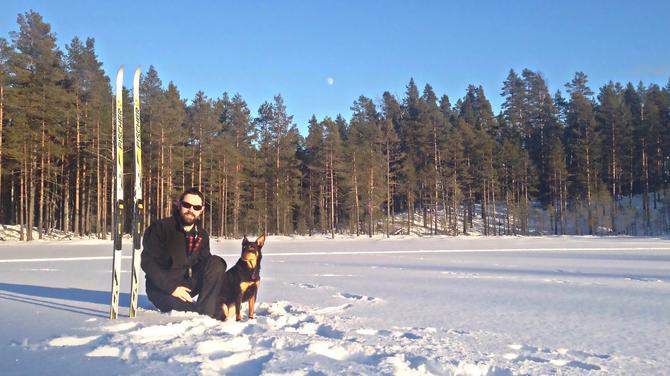If you knew there was a bear in the wilderness near you, what would you do?
For University of Tasmania graduate Jack Beardsley and his canine sidekick Cocoa, part of his job is to approach bears and see how they react.
As a member of the Scandinavian Brown Bear Research Project, it’s just another day at the office – and his office is the stunning Swedish wilderness.
A bear lover since childhood, Jack was very keen to join the project, which was established in 1984.
“I’ve always had a really strong interest in wildlife, particularly in bears. I’ve spent a lot of my own travel time in parts of the world with bear populations.
Bears are incredibly majestic animals. When you get up close to one in terms of their size and their presence, it’s absolutely remarkable. They’re incredibly intelligent as well.
“I think people right around the world have a strong affiliation with bears in some sense, right down to the teddy bears most people have as a child.”
Jack’s tasks on the project have included spatial analysis, data processing, collecting/examining scat samples, assisting with animal captures, marking and flight monitoring, and conducting studies into bear behaviour when humans intrude on their “safe space.”
As for approaching bears in the wild, Jack said it’s “not nearly as courageous as it sounds.”

“The bears that we have here – the Eurasian brown bear - are a subspecies of the brown bear. They are incredibly shy of people and you can count yourself as very lucky if you get to see one in the wild. The same concept doesn’t apply to other bear species in other parts of the world – that’s a very different story.
“When we conduct approaches, we behave like a typical person in a forest who has no idea the bears are there. Sometimes we don’t know they’re there. We use tracking collars to monitor where they are throughout the approach.
If you’re very lucky, you might get to briefly see the bear before it stands up and runs away.
“To my knowledge there’s been one, maybe two, possible signs of aggression in the project’s 30 plus-year history, and that is what we refer to as a ‘bluff charge.’
“The bears will occasionally stand on their hind legs to get a look at you, and to better understand who you are and why you’re there. Then, if they’re really uncomfortable, they might perform a bluff charge - run towards you and then veer to one side - in an attempt to scare you away."
Jack’s background in spatial sciences has proved helpful.
“My previous work was largely centred on glaciology and sea level work.
Cartography, remote sensing and GIS have been very applicable and useful in my current work.
“After completing my Honours I worked for the Integrated Marine Observing System and University of Tasmania developing, installing and maintaining high accuracy GPS systems around Tasmania and Antarctica respectively.
“That experience, particularly the technical background, has certainly been very applicable here because most of our bear population is now also fitted with GPS collars.”
Any government or private research bodies who have queries about bears in Scandinavia turn the Bear Project to find answers to their questions.
Basically, we are the people you go to if you have a question about Scandinavian bears and their role in the wider world.
“For example, the Project is working closely with other institutions to determine why bears in hibernation (who aren’t moving much) don’t develop things like bed sores or suffer severe muscle loss, like humans would in the same situation. We sample blood condition, muscle performance and other variables in our bears in both winter and summer, with the intent of applying our findings to improve human medical research.
“It’s been a wonderful opportunity and Sweden is a fantastic country to live in.
My colleagues think I’m completely insane for packing up my life and moving my dog and I to the other side of the world. But they’ve all been getting a great education on Australia, and particularly Tasmania, since I’ve arrived, Jack said.
“I intend to continue following my passions for spatial science and wildlife research into the future.”
Interested in following Jack's footsteps and studying a Bachelor of Surveying and Spatial Sciences? Find out more here.